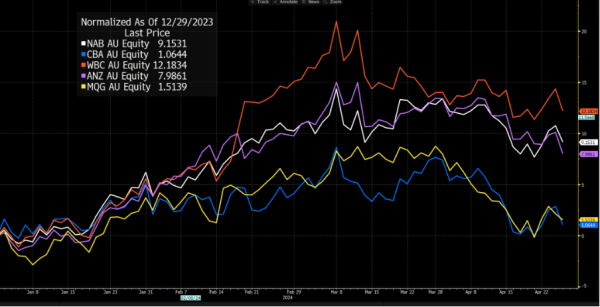ASX200 bank 1H24 earnings preview – why these earnings matter for traders
Given the ever-changing expectations of future RBA policy changes – with Australian interest rate futures now pricing in a slight hiking bias over the next six months - earnings from some of the key players at the forefront of lending, could get more attention than usual and the commentary, guidance and outlooks from the respective bank CEOs could move a broad suite of Aus-centric markets.
Bank earnings offer traders opportunity and risk
The bank earnings reports offer an opportunity for equity CFD traders, as the market rapidly reconciles expectations against the reality of how the respective businesses are tracking. Yet, it also poses risk for traders to efficiently manage - where we consider positioning, sentiment, and the potential for earnings re-rating. Where these factors can lead to gapping risk given they all report when the ASX200 cash market is closed.
From a macro perspective the banks are critically important within the financial eco-system and the trends they report on regarding asset quality, lending volumes, margins, and the outlook on expected economic trends can have a strong read-through to many other areas of the equity market, such as consumer stocks and REITS.
At a high level, the market expects a slight decline in the bank's cash earnings, driven by higher loan losses. However, with healthy capital levels, there will be a focus on dividends and payout ratios, but we may also see on-market share buybacks, which would boost earnings-per-share (EPS) – notably watch ANZ here, with speculation they may announce a $1b to $1.5b buyback.
Watch trends on asset quality and loan stress
Bad and doubtful debts will take centre stage, where expectations are for a slight rise, although nothing too alarming - where recent commentary from NAB and WBC highlighted that customers were adjusting well to higher repayments.
Despite the recent commentary, the asset quality of the banks will be under close scrutiny, with metrics like non-performing loans / gross loans and acceptance (GLA), bad and doubtful debt / GLAs and impaired assets / non-housing loans getting attention. Analysts will be looking through the numbers to see if there is any additional stress at a household or business level, and if any trends are unfolding around spending behaviours.
Any outlook on strategy will be of interest to shareholders, especially concerning NAB and the recent appointment of Andrew Irvine as CEO.
The guidance from CEOs on housing, interest rates and the resilience of the consumer could trigger a share price reaction.
 Preview
PreviewKey reporting dates and consensus expectations on key earnings metrics:
NAB (2 May): Cash earnings $3.564b (-2.6% vs 2h23), dividend 84.5c, net interest margin 1.68% (-3bp vs 2H23)
Macquarie (3 May): 2H24 EPS (adjusted) of $5.53, net income $2.17b, dividend $3.98.
Westpac (6 May): Cash earnings $3.242b (-3.1% vs 2h23), dividend 71c, net interest margin 1.91% (-1bp vs 2H23)
ANZ (7 May): Cash earnings $3.516B (-1% vs 2h23), dividend 81c, net interest margins 1.61% (-5bp vs 2H23)
Trading considerations and earnings pedigree:
NAB – NAB has performed well in 2024 with shares +9.15% YTD and easily outperforming the ASX200 (-0.2% YTD), with investors warming to the relative growth in revenue (versus its peers) and leverage from a strong SME business. The options market implies a -/+1.2% move in price on the day of earnings. In the past 8 half-year earnings report shares have closed higher 63%% of the time, with the average (absolute) move of 2.1%.
Macquarie – The options market implies a -/+2.7% move in price on the day of Macquarie’s earnings. In the past 8 half-year earnings report shares have closed higher 50% of the time, with the average (absolute) move of 2.24%. Shares have gained 1.3% YTD, modestly outperforming the ASX200. Having hit $200 on 28 March, shares have since carved out a range with good buying interest into $180 and sellers offloading exposures above $190 – can the earnings see a new trend in price develop?
Westpac – The best performer of the Big 4 banks, with shares gaining 12.2% YTD, with price pulling back 7% after reaching $27.70 in March. There has been some concern about the outlook for costs, and some analysts have suggested a weak customer franchise is problematic, although we have seen this play out in the share price. The options market implies a -/+3.3% move in the share price on the day of earnings - so traders are sensing upbeat movement here and the potential for a surprise in the report. In the past 8 half-year earnings report shares have closed higher 63% of the time, with the average (absolute) move of 3.4%.
ANZ – ANZ has held in well above $20 and the market seems to be happy to buy into dips into the figure and support price here. From a momentum perspective, I’d be a buyer on moves through $28.75, especially if we saw a rise in the rate of change. The options market implies a -/+2.6% move in price on the day of earnings. In the past 8 half-year earnings report shares have closed higher 50% of the time, with the average (absolute) move of 1.71%. Shares have gained 8.4% YTD, having a solid outperformance versus the ASX200.
Trade ASX200 equity CFDs on the MT5 platform
It promises to be an insightful earnings season, with CBA also providing a quarterly update. Put the banks and ASX200 equity CFDs on your radar. For information about trading share CFDs with Pepperstone reach out to the team.